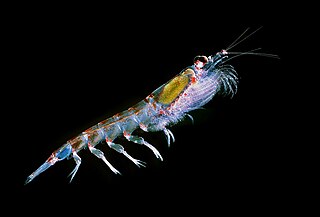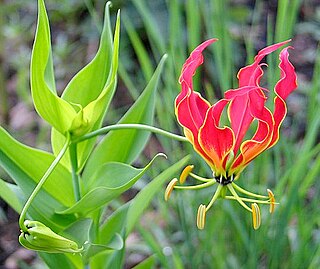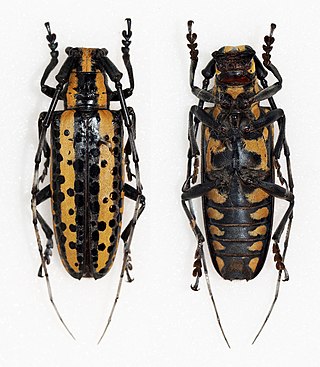
Antarctic krill is a species of krill found in the Antarctic waters of the Southern Ocean. It is a small, swimming crustacean that lives in large schools, called swarms, sometimes reaching densities of 10,000–30,000 individual animals per cubic metre. It feeds directly on minute phytoplankton, thereby using the primary production energy that the phytoplankton originally derived from the sun in order to sustain their pelagic life cycle. It grows to a length of 6 centimetres (2.4 in), weighs up to 2 grams (0.071 oz), and can live for up to six years. It is a key species in the Antarctic ecosystem and in terms of biomass, is one of the most abundant animal species on the planet – approximately 500 million metric tons.

The greater lophorina, also known as superb bird-of-paradise or greater superb bird-of-paradise, is a species of the Paradisaeidae (bird-of-paradise) family. It was considered the sole species in the genus until in 2017 it was recognised that there were three species.

The hybrid elm cultivar Ulmus × hollandica 'Superba' is one of a number of intermediate forms arising from the crossing of the Wych Elm U. glabra with a variety of Field Elm U. minor. Boulger tentatively (1881) and Green more confidently (1964) equated it with a hybrid elm cultivated in the UK by Masters at Canterbury in the early 19th century, known as "Masters' Canterbury Seedling" or simply the Canterbury Elm. Loudon examined a specimen sent by Masters and considered it a hybrid, calling it U. montana glabra major.
The 1904 Brooklyn Superbas finished in sixth place with a 65–97 record.
The 1900 Brooklyn Superbas captured their second consecutive National League championship by four and a half games. The Baltimore Orioles, which had been owned by the same group, folded after the 1899 season when such arrangements were outlawed, and a number of the Orioles' players, including star pitcher Joe McGinnity, were reassigned to the Superbas.
The 1899 Brooklyn Superbas season was the 16th season of the current-day Dodgers franchise and the ninth season in the National League. The team won the National League pennant with a record of 101–47, 8 games ahead of the Boston Beaneaters, after finishing tenth in 1898.

George Newell Chesebro was an American film actor. He appeared in more than 400 films between 1915 and 1954. He was born in Minneapolis, Minnesota and died in Los Angeles, California.
The elm cultivar Ulmus × hollandica 'Blandford' was listed by the Urban Forestry Administration (UFA) of the District Department of Transportation in Washington, D.C., as one of its 'street trees' in 2008. As the UFA has no further documentation to support it, the entry may be spurious, but it is most likely the tree is the wych elm cultivar Ulmus glabra 'Superba', known in the UK as the 'Blandford Elm' and introduced to the US in the early 20th century, or possibly the hybrid cultivar Ulmus × hollandica 'Superba' present in some American collections, including Garfield Park, Washington, D.C., in the mid-20th century.

Gloriosa superba is a species of flowering plant in the family Colchicaceae. Common names include flame lily, climbing lily, creeping lily, glory lily, gloriosa lily, tiger claw, and fire lily.

Deliathis is a genus of flat-faced longhorns in the beetle family Cerambycidae. There are about 15 described species in Deliathis, found in the Neotropics.
Deliathis batesi is a species of beetle in the family Cerambycidae. It was described by Charles Joseph Gahan in 1888. It is known from Mexico.
Deliathis buquetii is a species of beetle in the family Cerambycidae. It was described by Tasté in 1841, originally under the genus Taeniotes. It is known from Honduras, Belize, and Mexico. It contains the varietas Deliathis buquetii var. mira.

Deliathis diluta is a species of beetle in the family Cerambycidae. It was described by Charles Joseph Gahan in 1892. It is known from Mexico, Guatemala, El Salvador, and Nicaragua.

Deliathis impluviata is a species of beetle in the family Cerambycidae. It was described by Lacordaire in 1869. It is known from Mexico and Guatemala.

Deliathis incana is a species of beetle in the family Cerambycidae. It was described by Forster in 1771.

Deliathis nivea is a species of beetle in the family Cerambycidae. It was described by Henry Walter Bates in 1869. It is known from Nicaragua, Guatemala, Costa Rica, Honduras, and Panama.
Deliathis parincana is a species of beetle in the family Cerambycidae. It was described by Stephan von Breuning in 1971. It is known from Mexico.
Deliathis quadritaeniator is a species of beetle in the family Cerambycidae. It was described by White in 1846. It is known from Panama, Costa Rica, Ecuador, Colombia, and Venezuela.
Deliathis neonivea is a species of beetle in the family Cerambycidae. It was described by Stephan von Breuning in 1943, but the original name is a junior homonym of Deliathis nivea so its name was replaced in 2018. It is known from Mexico.

The wych elm cultivar Ulmus glabraHuds. 'Superba', Blandford Elm, with unusually large leaves, was raised by Gill's of Blandford Forum, Dorset, in the early 1840s as Ulmus montana superba and was quickly distributed to other UK nurseries. It was confirmed as a form of wych, and first described by Lindley in The Gardeners' Chronicle, 1845, later descriptions being added by Gill (1845) and Morren (1848), who called it U. montana var. superba. Morren had adopted the name 'Superba' from the Fulham nurseryman Osborne in 1844, who supplied him with the tree – presumably one of the nurseries supplied by Gill. Morren states that 'Superba', already in cultivation in England, was introduced to Belgium by Denis Henrard of Saint Walburge, Liège, that in 1848 it had been present in Belgium for only three years, and that this variety was the one described as 'Superba' by Osborne, whom Henrard had visited at his nursery in Fulham in September 1844. 'Blandford Elm', with leaves of the same dimensions, was soon for sale in the USA.










